Well my friend I really enjoy this thread. I like the tone you use and the photos and the insight. I am so impressed w/ your interpretation of this new world you are in. I only hope you keep the photos and the dialogue coming. Every day I check in to see if something new is on. thank you. :coffeedrink:I like the respect you have.thanks for sharing. I am enjoying the read.
You are using an out of date browser. It may not display this or other websites correctly.
You should upgrade or use an alternative browser.
You should upgrade or use an alternative browser.
La Vida Nica
- Thread starter Toyotero
- Start date
Toyotero
Explorer
Thanks for the interest :-D
Feliz y Próspero Año Nuevo to everyone!
I've been in Leon the last couple of days for the New Years celebration. Leon is the second largest city in the country, more affluent than the rest of the country and with a lot of college students going to the many universities here:
- UNAN (Universidad Nacional Autonoma de Nicaragua, UNAN-León) - the public university, no tuition.
- UDO (Universidad de Occidente)
- UCC (Universidad de Ciencias Comerciales)
- UCAN (Universidad Cristiana Autonoma de Nicaragua)
- UTN (Universidad Tecnologica de Nicaragua)
- Politecnico La Salle
- Escuela Taller San Sabastian - tuition free school
The saying around the country is that Leon is the city of doctors and lawyers... I've not seen any statistics, but I'd say that it probably has a higher percentage of educated people than many other cities of the world. Like I noted, two of the universities are tuition free, students just have to pay a modest registration fee, buy books (much cheaper than texts in the US, of course!) and be able to afford to not work while they are in school. UNAN's latest count is that it has 10,000 students.
Because of all these young people, Leon by far has the best night life that I've seen in the country, probably better than Managua or San Juan del Sur, and they throw a great new years celebration!
I've taken a lot of photos and videos, and it's been a "blast" (foreshadowing ) Unfortunately we forgot to bring the camera's USB cable, so I can't upload anything until next week.
) Unfortunately we forgot to bring the camera's USB cable, so I can't upload anything until next week.
In the meantime, I'll catch up on some old photos.
On nearly every street in Nicaragua, there are street venders, typically selling fruit, homemade food or packaged food (chiclets, etc).

When we first got to Matagalpa, a lot of the fruit sellers in the street were selling Pejibaye. This is a type of palm fruit. My wife and I both really liked them.... and interestingly, my wife had never seen them before (she lived in Nicaragua until she was 25). They appear to be a plant that grows in the northern highlands and not in the coastal plains of Leon where she is from.
Pijibay fruit in the bag from the street seller. It is boiled in water with oil floating on top, I believe to coat it when it is pulled out to keep it from drying out. Then you peal their thick skin and you can start eating the meat of the fruit. I also have one halved to show you the thickness of the meat and the large seed.
They taste like a mix between yucca root, quequisque and salt. (if that helps any )
)

I discovered a pejibaye tree on the plantation... You can see the fruit up at the base of the branches.

They have some great natural squirrel and monkey defense.


After eating 3 or 4 almost daily for a month, both the mrs and I are pretty burn out on them... just as well since they went out of season :-D
On thing that doesn't cease to be fun here is the amazing variety of strange fruits, some that seem familiar but are just a little different. For example the caribbean banana (here called a Guineo Caribe). They are shorter and fatter than a Cavendish banana (the standard yellow one in the USA) and the meat is kind of pinkish. The best part about them is that their flavor is much stronger than a Cavendish, almost like what banana candies taste like!

Bananas and plantains grow 'wild' everywhere around here... although, really nearly every banana plant that you see in the world was planted by someone. If you don't know about the history of bananas, it's a very interesting one that humans have heavily affected. Through cross breading, humans made a plant that produces a massive sterile fruit and reproduces through solely through sprouting from the roots . This is an interesting and quick article about them
the-unfortunate-sex-life-of-the-banana

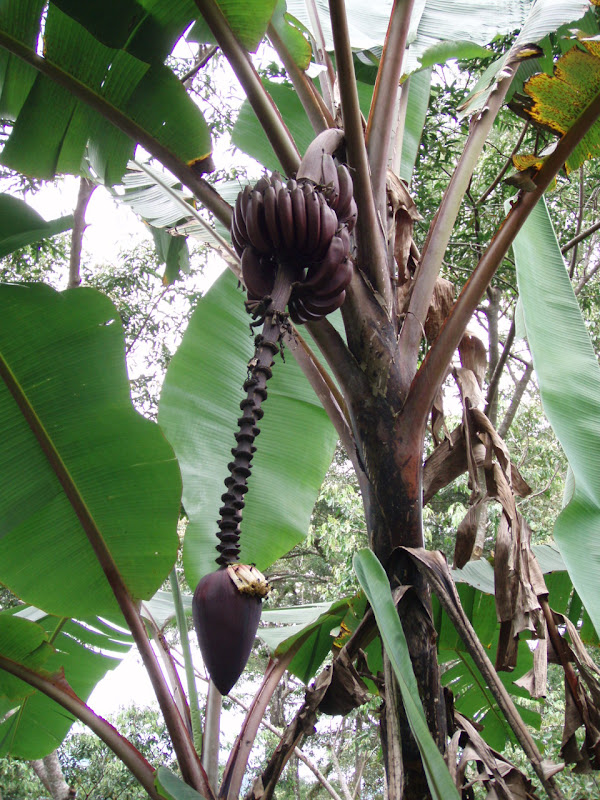
IMHO, the Nicaraguan people struggle primarily with two things - poverty and lack of education, more so in the countryside than in the cities. A lot of organizations try to educate the people through simple signs and posters. Here are a few that organizations gave to us that we have in our office.
The first one was interesting for me to see since the second method of water sterilization is one that I've read about that is promoted by the WHO - Solar Disinfection
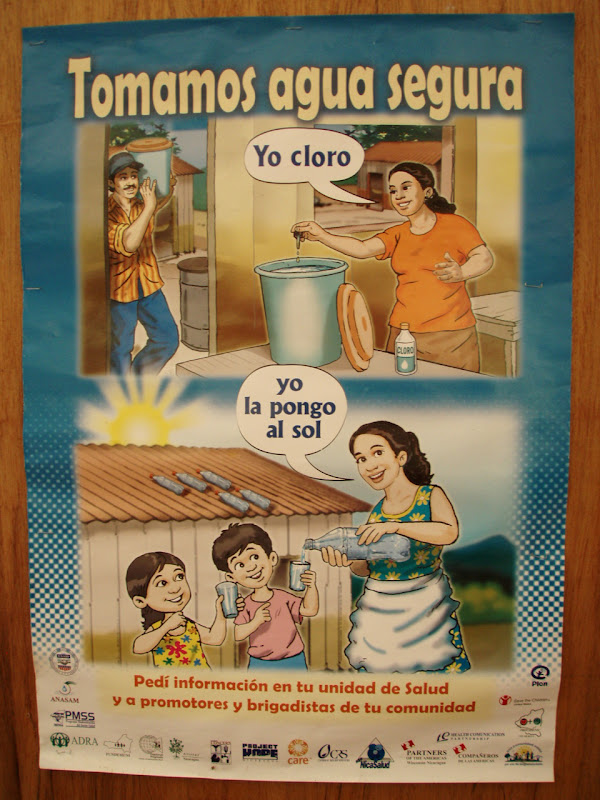
Infant and child malnutrition is a problem here as well... Infancia Sin Fronteras (Infancy without borders) works against it in the countryside in this area. These two posters educate parents about how to feed their baby and child.
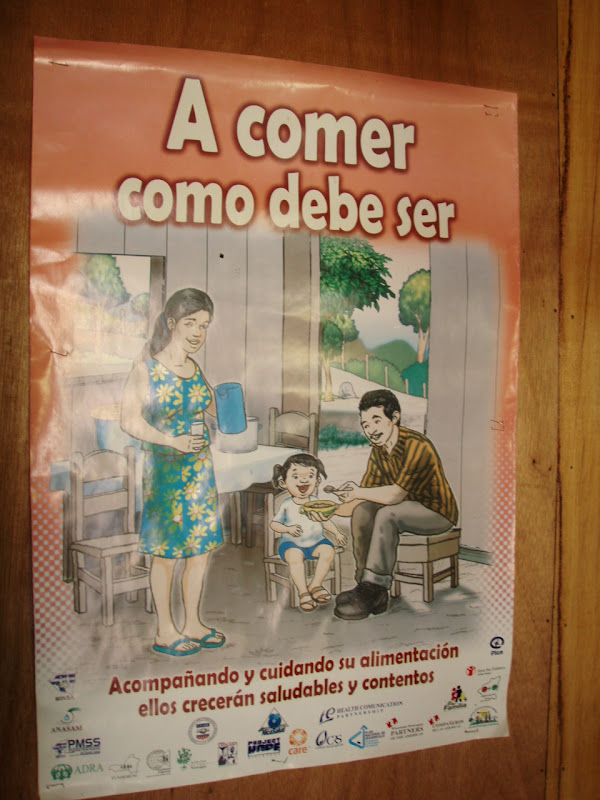

I'm still on the hunt for the elusive Hilux in good shape and for a decent price... One odd thing here is that used Toyotas retain their value incredibly well here. I saw a 1986 double cab 4WD Hilux online in Managua that the seller was asking $9,000 USD!!! Compare that to a 2003 I saw that sold for $13,000 USD! I recently saw a 1979 2WD banged up (typical condition) single-cab Hilux that the seller was asking $2,500! Back in the US, a seller couldn't get more than $300-$400 for that truck!
My guess is that the difference between here and the USA is that in the states, there is a surplus of used vehicles since credit (car loan) is readily available to nearly anyone and credit is relatively cheap (low interest rate). Here, few people can afford a new car, so for the majority that need a car for their business or personal use, the few thousand difference in price that a used car costs can make a big difference since they are probably paying cash or getting credit for rather un-attractive rates; auto loans here at BAC are currently 20% down, ~10% interest and 1.5% commission. Compare that to current rates in the US - 3% interest and 100% financed used car loan at my old CU!
At least the occasional sighting of a sweet classic confirms that they aren't extinct yet!
:-D

Feliz y Próspero Año Nuevo to everyone!
I've been in Leon the last couple of days for the New Years celebration. Leon is the second largest city in the country, more affluent than the rest of the country and with a lot of college students going to the many universities here:
- UNAN (Universidad Nacional Autonoma de Nicaragua, UNAN-León) - the public university, no tuition.
- UDO (Universidad de Occidente)
- UCC (Universidad de Ciencias Comerciales)
- UCAN (Universidad Cristiana Autonoma de Nicaragua)
- UTN (Universidad Tecnologica de Nicaragua)
- Politecnico La Salle
- Escuela Taller San Sabastian - tuition free school
The saying around the country is that Leon is the city of doctors and lawyers... I've not seen any statistics, but I'd say that it probably has a higher percentage of educated people than many other cities of the world. Like I noted, two of the universities are tuition free, students just have to pay a modest registration fee, buy books (much cheaper than texts in the US, of course!) and be able to afford to not work while they are in school. UNAN's latest count is that it has 10,000 students.
Because of all these young people, Leon by far has the best night life that I've seen in the country, probably better than Managua or San Juan del Sur, and they throw a great new years celebration!
I've taken a lot of photos and videos, and it's been a "blast" (foreshadowing
In the meantime, I'll catch up on some old photos.
On nearly every street in Nicaragua, there are street venders, typically selling fruit, homemade food or packaged food (chiclets, etc).
When we first got to Matagalpa, a lot of the fruit sellers in the street were selling Pejibaye. This is a type of palm fruit. My wife and I both really liked them.... and interestingly, my wife had never seen them before (she lived in Nicaragua until she was 25). They appear to be a plant that grows in the northern highlands and not in the coastal plains of Leon where she is from.
Pijibay fruit in the bag from the street seller. It is boiled in water with oil floating on top, I believe to coat it when it is pulled out to keep it from drying out. Then you peal their thick skin and you can start eating the meat of the fruit. I also have one halved to show you the thickness of the meat and the large seed.
They taste like a mix between yucca root, quequisque and salt. (if that helps any
I discovered a pejibaye tree on the plantation... You can see the fruit up at the base of the branches.
They have some great natural squirrel and monkey defense.
After eating 3 or 4 almost daily for a month, both the mrs and I are pretty burn out on them... just as well since they went out of season :-D
On thing that doesn't cease to be fun here is the amazing variety of strange fruits, some that seem familiar but are just a little different. For example the caribbean banana (here called a Guineo Caribe). They are shorter and fatter than a Cavendish banana (the standard yellow one in the USA) and the meat is kind of pinkish. The best part about them is that their flavor is much stronger than a Cavendish, almost like what banana candies taste like!
Bananas and plantains grow 'wild' everywhere around here... although, really nearly every banana plant that you see in the world was planted by someone. If you don't know about the history of bananas, it's a very interesting one that humans have heavily affected. Through cross breading, humans made a plant that produces a massive sterile fruit and reproduces through solely through sprouting from the roots . This is an interesting and quick article about them
the-unfortunate-sex-life-of-the-banana
IMHO, the Nicaraguan people struggle primarily with two things - poverty and lack of education, more so in the countryside than in the cities. A lot of organizations try to educate the people through simple signs and posters. Here are a few that organizations gave to us that we have in our office.
The first one was interesting for me to see since the second method of water sterilization is one that I've read about that is promoted by the WHO - Solar Disinfection
Infant and child malnutrition is a problem here as well... Infancia Sin Fronteras (Infancy without borders) works against it in the countryside in this area. These two posters educate parents about how to feed their baby and child.
I'm still on the hunt for the elusive Hilux in good shape and for a decent price... One odd thing here is that used Toyotas retain their value incredibly well here. I saw a 1986 double cab 4WD Hilux online in Managua that the seller was asking $9,000 USD!!! Compare that to a 2003 I saw that sold for $13,000 USD! I recently saw a 1979 2WD banged up (typical condition) single-cab Hilux that the seller was asking $2,500! Back in the US, a seller couldn't get more than $300-$400 for that truck!
My guess is that the difference between here and the USA is that in the states, there is a surplus of used vehicles since credit (car loan) is readily available to nearly anyone and credit is relatively cheap (low interest rate). Here, few people can afford a new car, so for the majority that need a car for their business or personal use, the few thousand difference in price that a used car costs can make a big difference since they are probably paying cash or getting credit for rather un-attractive rates; auto loans here at BAC are currently 20% down, ~10% interest and 1.5% commission. Compare that to current rates in the US - 3% interest and 100% financed used car loan at my old CU!
At least the occasional sighting of a sweet classic confirms that they aren't extinct yet!
:-D
Last edited:
We are heading down your way...as for Toyota truck, a lot of older pickup and 4Runner are imported in Guatemala and I suppose Nicaragua tambien.
I just saw a truck today carrying at least 5 or 6 of these, some still with plates from Tenessee!
I just saw a truck today carrying at least 5 or 6 of these, some still with plates from Tenessee!
greentruck
Adventurer
At least the occasional sighting of a sweet classic confirms that they aren't extinct yet!
:-D

Yeah! Nice photo, that's a classic.
Matagalpa was the first place I ever saw a dual cab/crewcab Toyota 4x4 -- in 1982. I'd heard of such things in 4x4 mags, but suddenly there one was in the flesh, so to speak. :wings:
Didn't get a pic, though.
The US market didn't get any until sometime in the 90s, IIRC.
Toyotero
Explorer
We are heading down your way...as for Toyota truck, a lot of older pickup and 4Runner are imported in Guatemala and I suppose Nicaragua tambien.
I just saw a truck today carrying at least 5 or 6 of these, some still with plates from Tenessee!
I have lived in Boulder/Denver on I-25 and Austin on I-35 and in both places I saw what I called 'road trains' of cars going south. A truck or van towing another truck towing a car or small truck. I saw hundreds of them. I knew they were being exported south but I always wondered how they could make any money considering the time it takes to drive, the price of gas, insurance, border fees, etc. Now that I've seen the price of cars here, not to mention the very low price of labor to fix up a car (mechanic, body, paint, etc), I understand how the business works.
Yeah! Nice photo, that's a classic.
Matagalpa was the first place I ever saw a dual cab/crewcab Toyota 4x4 -- in 1982. I'd heard of such things in 4x4 mags, but suddenly there one was in the flesh, so to speak. :wings:
Didn't get a pic, though.
The US market didn't get any until sometime in the 90s, IIRC.
I think that the 2001 Tacoma double cab (available in 2000) was the first US market double cab mini truck.
What you say reminds me of the first time I saw an 1982 or 83 body style double cab hilux... I had thought that they didn't offer it until the 1984 model! Little did I know that I would later see a double cab Stout! (photo to come)
Regards,
Last edited:
4x4x4doors
Explorer
Also enjoying the read and pictures.
The high shelf life milk comment surprised me. It's been available in the US since the 80s at least. I've always seen it in box rather than bag though.
[ame="http://www.amazon.com/Organic-Valley-Ultra-Pasteurized-Whole/dp/B001HTLA7U"]Organic Valley Ultra Pasteurized Whole Milk, 33.8 Ounce (Pack of 12): Amazon.com: Grocery & Gourmet Food[/ame]
The high shelf life milk comment surprised me. It's been available in the US since the 80s at least. I've always seen it in box rather than bag though.
[ame="http://www.amazon.com/Organic-Valley-Ultra-Pasteurized-Whole/dp/B001HTLA7U"]Organic Valley Ultra Pasteurized Whole Milk, 33.8 Ounce (Pack of 12): Amazon.com: Grocery & Gourmet Food[/ame]
Toyotero
Explorer
Also enjoying the read and pictures.
The high shelf life milk comment surprised me. It's been available in the US since the 80s at least. I've always seen it in box rather than bag though.
Organic Valley Ultra Pasteurized Whole Milk, 33.8 Ounce (Pack of 12): Amazon.com: Grocery & Gourmet Food
Interesting, I first saw this kind of milk when I live in Puebla, MX for school 10 years ago and I hadn't seen it again until I moved here. Perhaps I just never walk down the right isle at HEB in the US :-D It seems to be more common in countries where many of the people don't have refrigerators.
Toyotero
Explorer
Chinese trucks
It's been a while since I could make time to post. The busy time of the year at my job just ended last week, so I'm looking forward to a few months of more tranquility and maybe some more travel around the country :-D
I just noticed that the link for one of my videos of the rubber trees was set a private and not visible. It's set so that it can be viewed with the link.
Here is a photo I mentioned recently... It's a quick somewhat poorly framed shot I took of a 4 door Toyota Stout. I was in Managua's "Mercado Oriental" which is famous for being the place to get hard to find stuff, black market items and getting robbed so I didn't want to be flashing a camera around too much.
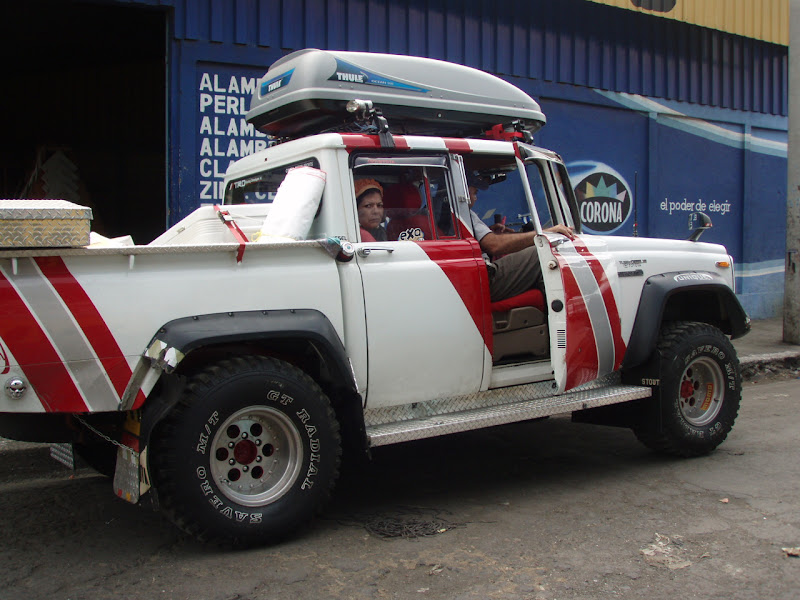
The Chinese Trucks that look like Toyotas has been something of interest to me lately... There seems to be a few brands, FAW and Great Wall.
Interestingly, Wikipedia says that Great Walls trucks are badge engineered vehicles, meaning that they contract Toyota to build them and badge them as their own (much like the Volkswagen Taro )
Here is one that I saw in Leon on Jan 2:




Here is a 4 door that I saw in Matagalpa on Jan 21. I spoke with the owner and he told me that it is a 2008 model... if it's badge engineered, it's odd since Toyota stopped making the 6th generation body style in 2004.

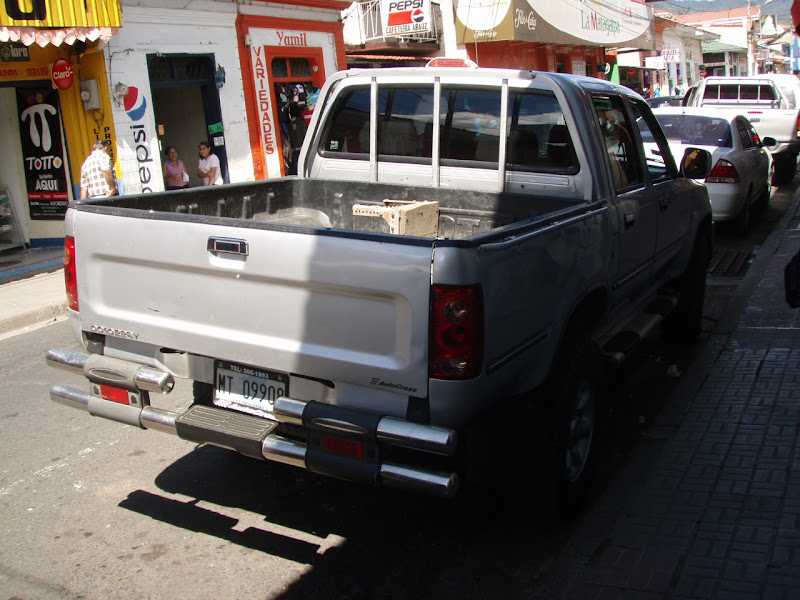
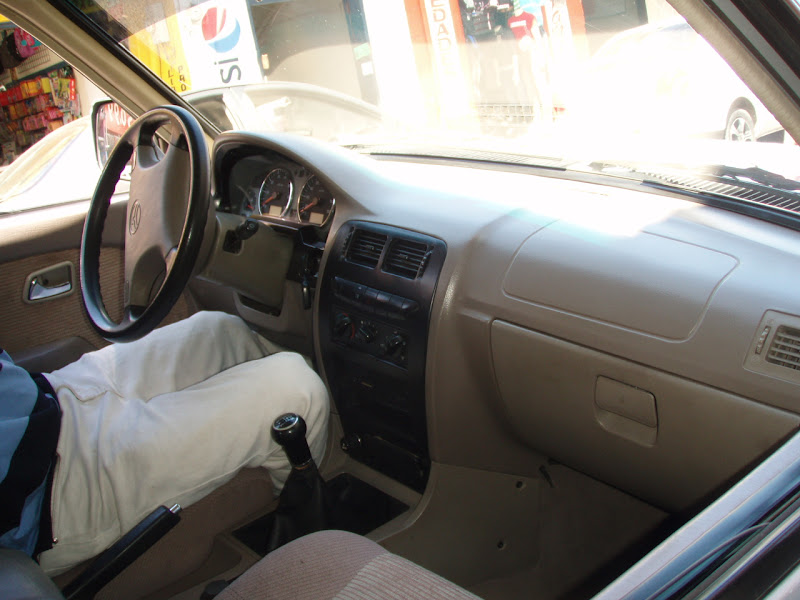
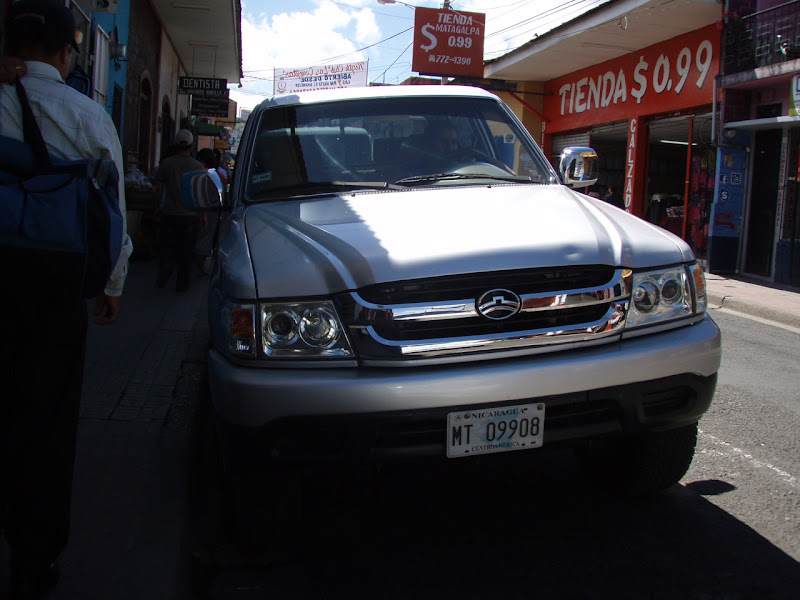
Here's another Chinese truck who's styling looks familiar...


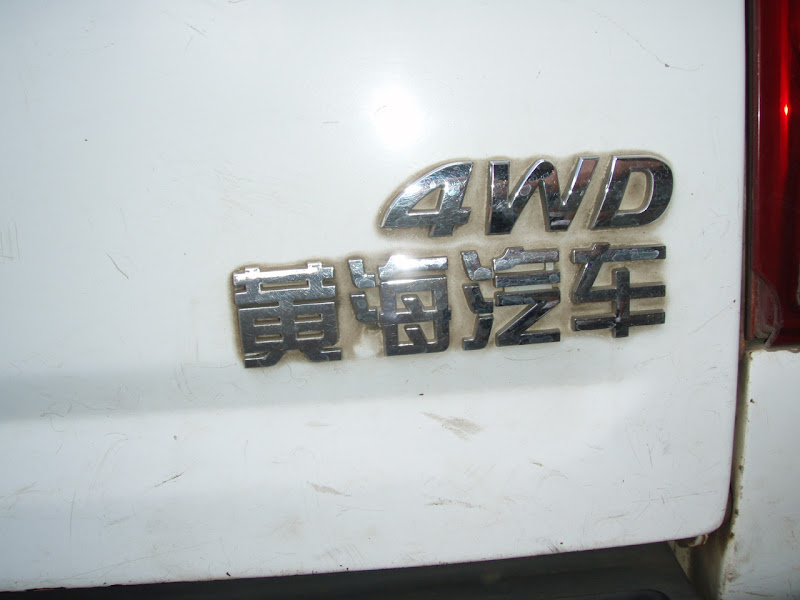
Like I mentioned before, the señora and I made it over to Leon for New Years Eve since it's a very lively city. On the street where my wife's family lives, they closed it off and everyone moved their dinner table and chairs out onto the sidewalk or the street. There was lots of eating, drinking, music and dancing until very early in the morning.
I probably should have been drinking Flor de Cana, but I'm a big fan of the bat :-D


There is a tradition here that some people do of stuffing a dummy made of old clothes to represent the old year.

At the stroke of midnight, they light him on fire.... no one told the gringo that the kerosene soaked rags were also stuffed with fireworks!
http://www.youtube.com/watch?v=cpNqXItk6Z8
There was not much left of the old year :-D

Leon is always fun because of the colonial style to all the buildings and the old world feel that it has.
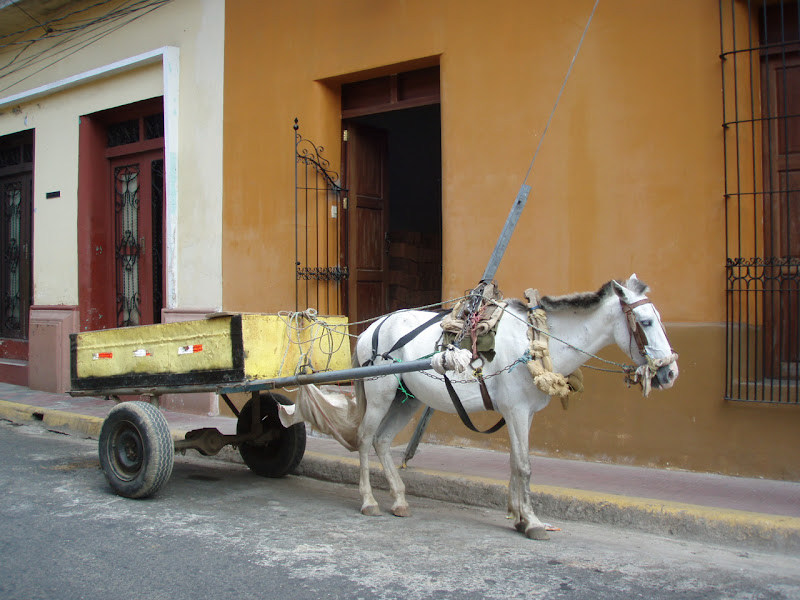
Near the center of town there is the old market that really has the feel of a third world market.
Market scene.

Sea food... including turtle eggs. 60 Cordoba (~ $2.70USD) per dozen.

This time this seller had an iguana and lot more garrobos than last time... all alive and tied up to keep them fresh.


One of my favorite aspects of my job isthat daily I'm able to get out and see some interesting things in the country side; plants, animals, views, etc.

This is a great looking tree up near the Cerro Apante nature reserve.

Here is a plant that has a great defense against grazing animals...
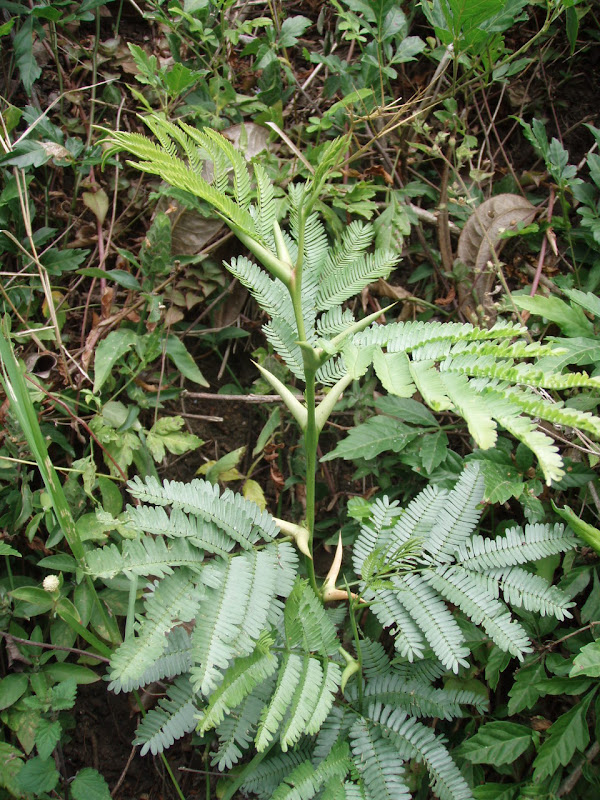
Soft leaves and stems but with some seriously thick and rigid thorns.

cont'
It's been a while since I could make time to post. The busy time of the year at my job just ended last week, so I'm looking forward to a few months of more tranquility and maybe some more travel around the country :-D
I just noticed that the link for one of my videos of the rubber trees was set a private and not visible. It's set so that it can be viewed with the link.
Here is a photo I mentioned recently... It's a quick somewhat poorly framed shot I took of a 4 door Toyota Stout. I was in Managua's "Mercado Oriental" which is famous for being the place to get hard to find stuff, black market items and getting robbed so I didn't want to be flashing a camera around too much.
The Chinese Trucks that look like Toyotas has been something of interest to me lately... There seems to be a few brands, FAW and Great Wall.
Interestingly, Wikipedia says that Great Walls trucks are badge engineered vehicles, meaning that they contract Toyota to build them and badge them as their own (much like the Volkswagen Taro )
Here is one that I saw in Leon on Jan 2:
Here is a 4 door that I saw in Matagalpa on Jan 21. I spoke with the owner and he told me that it is a 2008 model... if it's badge engineered, it's odd since Toyota stopped making the 6th generation body style in 2004.
Here's another Chinese truck who's styling looks familiar...
Like I mentioned before, the señora and I made it over to Leon for New Years Eve since it's a very lively city. On the street where my wife's family lives, they closed it off and everyone moved their dinner table and chairs out onto the sidewalk or the street. There was lots of eating, drinking, music and dancing until very early in the morning.
I probably should have been drinking Flor de Cana, but I'm a big fan of the bat :-D
There is a tradition here that some people do of stuffing a dummy made of old clothes to represent the old year.
At the stroke of midnight, they light him on fire.... no one told the gringo that the kerosene soaked rags were also stuffed with fireworks!
http://www.youtube.com/watch?v=cpNqXItk6Z8
There was not much left of the old year :-D
Leon is always fun because of the colonial style to all the buildings and the old world feel that it has.
Near the center of town there is the old market that really has the feel of a third world market.
Market scene.
Sea food... including turtle eggs. 60 Cordoba (~ $2.70USD) per dozen.
This time this seller had an iguana and lot more garrobos than last time... all alive and tied up to keep them fresh.
One of my favorite aspects of my job isthat daily I'm able to get out and see some interesting things in the country side; plants, animals, views, etc.
This is a great looking tree up near the Cerro Apante nature reserve.
Here is a plant that has a great defense against grazing animals...
Soft leaves and stems but with some seriously thick and rigid thorns.
cont'
Last edited:
Toyotero
Explorer
It's good to see that the government is doing something to try to conserve the native plants and animals since generally speaking, in the culture there is little importance given to it. The Cerro Apante Nature Reserve is basically a mountain that is cordoned off and protected from hunting, woodcutting, etc. There is a rough dirt road that skirts along its border that I frequent, and it is a beautiful drive with occasional sitings of interesting plants and animals (such as the tree posted in my last post). Late one evening recently, I saw a very large cat cross the road at the edge of my headlights (no photo unfortunately).

Near the Cerro Apante nature reserve, I encountered this little guy in a puddle so I rescued him... he was kind of beat up, but I think he made it. It's called a Mariposa Ala Azul (blue winged butterfly)
[ame="http://www.youtube.com/watch?v=Mk5YJYF1az8"]YouTube - Mariposa Ala Azul near Apante Reserve Natural[/ame]
An absurdity.
As I mentioned before, some things here seem just seem absurd to me, this next image is of one. There is an area on the side of the highway near town that is being leveled for the construction of a building. I'm not sure when they started, but it looks like a year ago or more. One thing I noticed on the site is this below... remember, this used to be a hill, so they've excavated a lot of dirt and rock to bring it down level, and it appears that no one bothered to call the electric company...
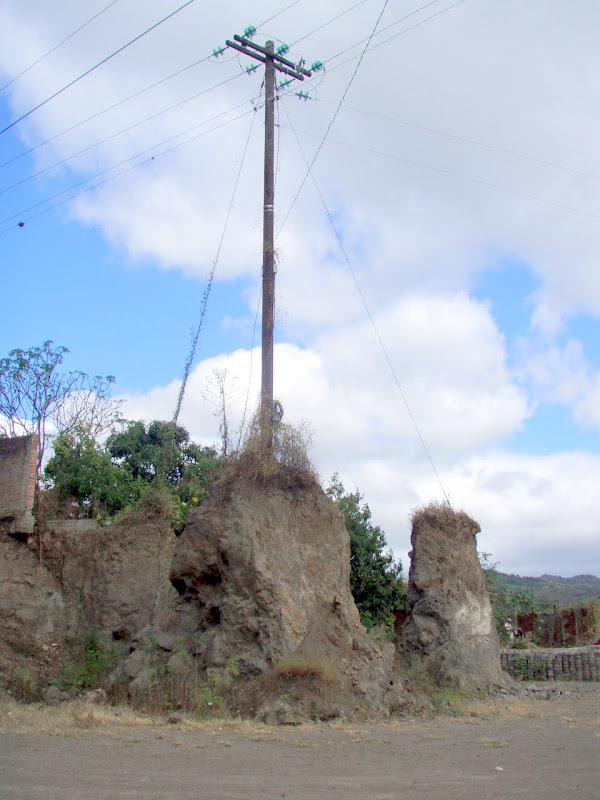
That has been like that for at least 5 months since I moved here.
Everywhere in Nicaragua, there is a serious problem with substance abuse. In the country, low quality alcohol is readily available and inexpensive, even for people who make just $5 per day in the smallest villages. Pints of "Caballito" and "Cañita" are the bottles I most commonly see discarded in the gutter, in parks and on doorsteps, so I assume that it is the cheapest... I'd estimate around $1 USD per bottle, although I've not yet even seen where it is sold.

Before coming here, I'd heard the old expression of a drunk passed out in the gutter but I'd never before actually seen someone sleeping in the gutter. Here, seeing it is literal a daily occurrence in town and sometimes out in the country... Last week, I encountered this fellow in the next photo a few miles outside of town. I was quite concerned when I first saw him lying there in that position... I've never encountered a hit and run, but I suspect that this is what it looks like... but upon closer inspection I could see that he was simply passed out. This was at 1 in the afternoon.
I hope there aren't any ants nearby. ...btw, there are ants EVERYWHERE.

Ending on a highnote, here is something you won't see in your local dealership anytime soon:


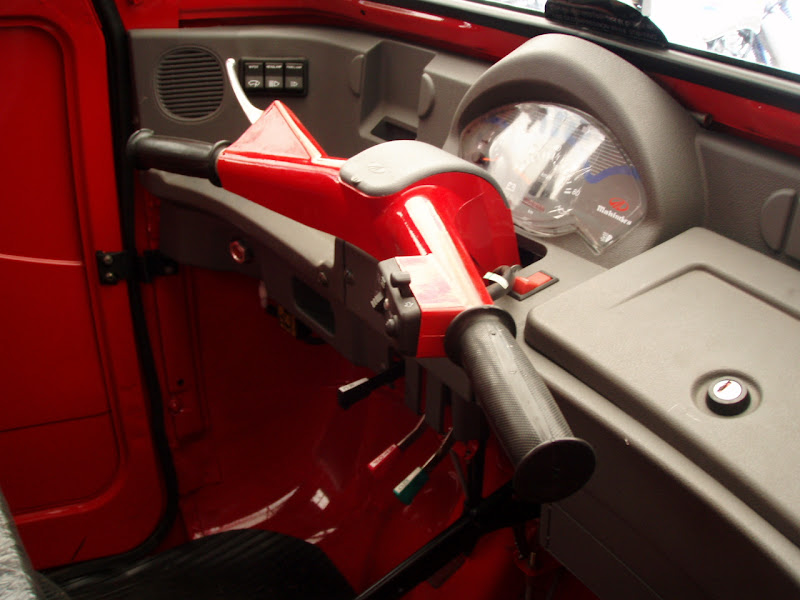
Two things that make me not feel so far from home... my wife and Walmart propaganda..

Photo taken in Pali Supermercado (owned by Walmart, as well as LA Union chain of supermarkets here).
Saludos,
Near the Cerro Apante nature reserve, I encountered this little guy in a puddle so I rescued him... he was kind of beat up, but I think he made it. It's called a Mariposa Ala Azul (blue winged butterfly)
[ame="http://www.youtube.com/watch?v=Mk5YJYF1az8"]YouTube - Mariposa Ala Azul near Apante Reserve Natural[/ame]
An absurdity.
As I mentioned before, some things here seem just seem absurd to me, this next image is of one. There is an area on the side of the highway near town that is being leveled for the construction of a building. I'm not sure when they started, but it looks like a year ago or more. One thing I noticed on the site is this below... remember, this used to be a hill, so they've excavated a lot of dirt and rock to bring it down level, and it appears that no one bothered to call the electric company...
That has been like that for at least 5 months since I moved here.
Everywhere in Nicaragua, there is a serious problem with substance abuse. In the country, low quality alcohol is readily available and inexpensive, even for people who make just $5 per day in the smallest villages. Pints of "Caballito" and "Cañita" are the bottles I most commonly see discarded in the gutter, in parks and on doorsteps, so I assume that it is the cheapest... I'd estimate around $1 USD per bottle, although I've not yet even seen where it is sold.
Before coming here, I'd heard the old expression of a drunk passed out in the gutter but I'd never before actually seen someone sleeping in the gutter. Here, seeing it is literal a daily occurrence in town and sometimes out in the country... Last week, I encountered this fellow in the next photo a few miles outside of town. I was quite concerned when I first saw him lying there in that position... I've never encountered a hit and run, but I suspect that this is what it looks like... but upon closer inspection I could see that he was simply passed out. This was at 1 in the afternoon.
I hope there aren't any ants nearby. ...btw, there are ants EVERYWHERE.
Ending on a highnote, here is something you won't see in your local dealership anytime soon:
Two things that make me not feel so far from home... my wife and Walmart propaganda..
Photo taken in Pali Supermercado (owned by Walmart, as well as LA Union chain of supermarkets here).
Saludos,
Last edited:
Toyotero
Explorer
This is interesting Nicargaua news. As I noted before, one cool thing about Nicaragua is all the Soviet and Eastern Block vehicles here. Ladas, Nivas, UAZs, Zils, IFA w50s, Kamaz, etc... but they are all now 20 years old or more and being replaced by Kias and Isuzus...
Well, Nicaragua is about to get an influx of Russian vehicles:
Well, Nicaragua is about to get an influx of Russian vehicles:
http://english.ruvr.ru/2011/02/13/44114253.html
Russain cars for Nicaraguan cabbies
450 Russian-made Lada cars were handed over to Nicaraguan taxi drivers in a ceremony that was held in the capital Managua and attended by President Daniel Ortega on Saturday.
He said that 1,000 more Ladas will be delivered to Nicaragua in the near future, which Ortega explained will help modernize his country’s taxicab fleet.
He added that Nicaragua also plans to purchase at least 200 Russian-made buses.
Russain cars for Nicaraguan cabbies
450 Russian-made Lada cars were handed over to Nicaraguan taxi drivers in a ceremony that was held in the capital Managua and attended by President Daniel Ortega on Saturday.
He said that 1,000 more Ladas will be delivered to Nicaragua in the near future, which Ortega explained will help modernize his country’s taxicab fleet.
He added that Nicaragua also plans to purchase at least 200 Russian-made buses.
Toyotero
Explorer
I realized that it's been 10 years since I had an IV... as the doctora was poking me for the 5th time trying to hit a vein without it collapsing due to severe dehydration...
I've been out of commission since Sunday... the doc diagnosed it as disentery. Been getting a shot in the buttox of antibiotics daily for 6 days now (one more to go) and been taking 5 different oral medications daily...
Lesson learned? Be careful who you shake hands with while out in the country... alcohol gel is your friend when interacting with the rural uneducated workers who have different standards of hygiene.
I suggested to the wife that if I didn't make it, my tombstone should read "Gene has died of dysentery". Nicaraguans apparently didn't play "Oregon Trail" in their middle schools, so the joke went over like a lead balloon. Hey, if I'm going to be suffering from a potentially fatal third world gastrointestinal infection, I'm going to make jokes about it!
The upside is that meds, IV and daily visits to the doctor have cost a total of about $35... cheap for a gringo, but it'd be a hard price to swallow most rural Nica nationals ($430 USD annual per capita income). Interesting, the meds are made in India, El Salvador and Puerto Rico.
This is what I have left after 3 days of treatment and felt up to taking the photo.
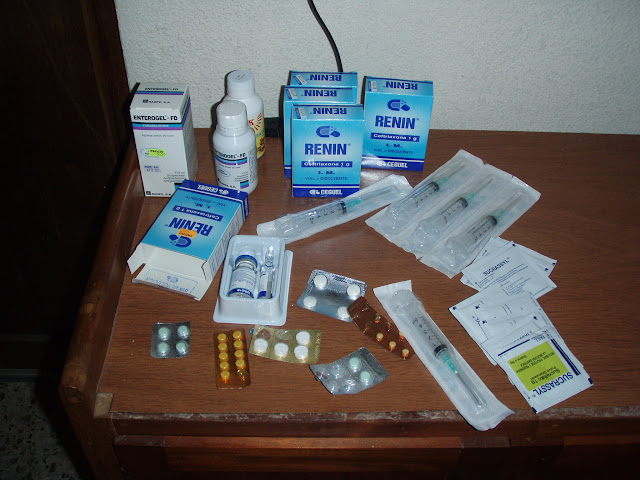
It looks like the "fun table" in Black Sabbath's dressing room.
This is the fun one... thank goodness for the vial of lidocaine, I can't imagine how much it would hurt without that in the mix. As is, I feel like someone played futbol (soccer) with my butt.

The good news is that I'm making a great recovery. A big thanks to my señorita for keeping track of what I take and when with accountant like precision! I don't think I would be doing so hot now had I had it to do alone :-/
Here are a few interesting photos that I took before I got the gut bug.
Armored cars that are used, from what I've seen, to transport money to and from the banks in Managua to Matagalpa. I'm guessing that they are old EU armored trucks?

I saw this bad boy here in town...

An interesting build, especially the 70 series snorkel.
Since the mid-80s and 90s Toyota Hiluxes weren't badged, Nicaraguans refer to them all as Toyota 22Rs, after the common 4 cylinder engine in them. Some people have even gone so far as having the name painted onto their vehicle:

I've been out of commission since Sunday... the doc diagnosed it as disentery. Been getting a shot in the buttox of antibiotics daily for 6 days now (one more to go) and been taking 5 different oral medications daily...
Lesson learned? Be careful who you shake hands with while out in the country... alcohol gel is your friend when interacting with the rural uneducated workers who have different standards of hygiene.
I suggested to the wife that if I didn't make it, my tombstone should read "Gene has died of dysentery". Nicaraguans apparently didn't play "Oregon Trail" in their middle schools, so the joke went over like a lead balloon. Hey, if I'm going to be suffering from a potentially fatal third world gastrointestinal infection, I'm going to make jokes about it!
The upside is that meds, IV and daily visits to the doctor have cost a total of about $35... cheap for a gringo, but it'd be a hard price to swallow most rural Nica nationals ($430 USD annual per capita income). Interesting, the meds are made in India, El Salvador and Puerto Rico.
This is what I have left after 3 days of treatment and felt up to taking the photo.
It looks like the "fun table" in Black Sabbath's dressing room.
This is the fun one... thank goodness for the vial of lidocaine, I can't imagine how much it would hurt without that in the mix. As is, I feel like someone played futbol (soccer) with my butt.
The good news is that I'm making a great recovery. A big thanks to my señorita for keeping track of what I take and when with accountant like precision! I don't think I would be doing so hot now had I had it to do alone :-/
Here are a few interesting photos that I took before I got the gut bug.
Armored cars that are used, from what I've seen, to transport money to and from the banks in Managua to Matagalpa. I'm guessing that they are old EU armored trucks?
I saw this bad boy here in town...
An interesting build, especially the 70 series snorkel.
Since the mid-80s and 90s Toyota Hiluxes weren't badged, Nicaraguans refer to them all as Toyota 22Rs, after the common 4 cylinder engine in them. Some people have even gone so far as having the name painted onto their vehicle:
Last edited:
greentruck
Adventurer
Ugh, get well soon!
I was fortunate in my two trips to Nicaragua to have only a very brief and minor "inconvenience" on one of them. As a former Scout and regular back-country camper, I managed pretty well by applying the basics to my own habits.
Lots of people I traveled with were not so lucky. I can still remember the 4am breakfast call for the bus that took us from a coffee farm near Matagalpa to Rama, where we boarded the boat for Bluefields. It was a long day for me, but two of my compas did it starting out in towel diapers!:smiley_drive:
Of course is you're that sick, you didn't worry about the possibility of contra attack quite so much:Wow1:
History changes, but the little bugs continue to afflict us all equally.
I was fortunate in my two trips to Nicaragua to have only a very brief and minor "inconvenience" on one of them. As a former Scout and regular back-country camper, I managed pretty well by applying the basics to my own habits.
Lots of people I traveled with were not so lucky. I can still remember the 4am breakfast call for the bus that took us from a coffee farm near Matagalpa to Rama, where we boarded the boat for Bluefields. It was a long day for me, but two of my compas did it starting out in towel diapers!:smiley_drive:
Of course is you're that sick, you didn't worry about the possibility of contra attack quite so much:Wow1:
History changes, but the little bugs continue to afflict us all equally.
Toyotero
Explorer
I was fortunate in my two trips to Nicaragua to have only a very brief and minor "inconvenience" on one of them. As a former Scout and regular back-country camper, I managed pretty well by applying the basics to my own habits.
One thing I've never mentioned about life here is the high frequency of urination and defecation that happens in public areas. In the northern country (IE, it's much less common in Leon), I see men urinating in public, both urban and rural areas, about a dozen times per day. I've not seen anyone in the act of defecating in public, but I walk up on the evidence about once or twice per day. I've nearly stepped in human waste several times, but luckily the sound of the hundreds of flies often alerts one to it's presence.
I actually got sick due to contamination at a company function... 250 people crowded together for about 8 hours sharing food and drink... and no bathroom facilities access. I simply waited until I went back home. The locals excused themselves to the nearest out-of-sight area and took care of business w/o proper paper, using leaves or such. I'd heard of the risk of fecal contamination when shaking the hands of the locals, now I know it all too well. I'm an Eagle Scout with extensive backcountry experience also, but the risk factors here are substantially higher than any camping trip.
I'm feeling 99% back to normal now... waiting until tomorrow morning to get the results from a test to see if I'm parasite free. Today was the first morning in a week to not have to get a shot in the glutous maximus.
One more personal favorite photo I took recently. This bug is about 8 inches from the front legs to the rear... and he made a heck of a angry buzzing noise when I moved him to the leaf for the photo!
greentruck
Adventurer
That is one creepy looking bug.
Forum statistics
Members online
- shaggyg
- 80t0ylc
- valcon1
- Pau Hana
- gnel
- brogo
- JMacs
- Leegriff
- warrpath4x4
- Eric93k
- FireJeep
- eXpeditionXterra
- benSan
- crismateski
- nargun
- explore_more
- pedalwrench
- matttahoe53
- OVRLNDFX4
- Mekcanix
- baublebiker
- RunnerCT
- gwittman
- landy66
- Bespoke
- geovangelist
- rickgibbs
- SimplyAnAdventure
- rruff
- Sparks912
- mmth_ski_bum
- Savagenut
- fisher205
- shabba
- Fenderfour
- Roam.Wild
- Ducksksr
- SteepnDeep
- anthraciteadventures
- jgallo1
- welikecamping2
Total: 2,215 (members: 42, guests: 2,173)
